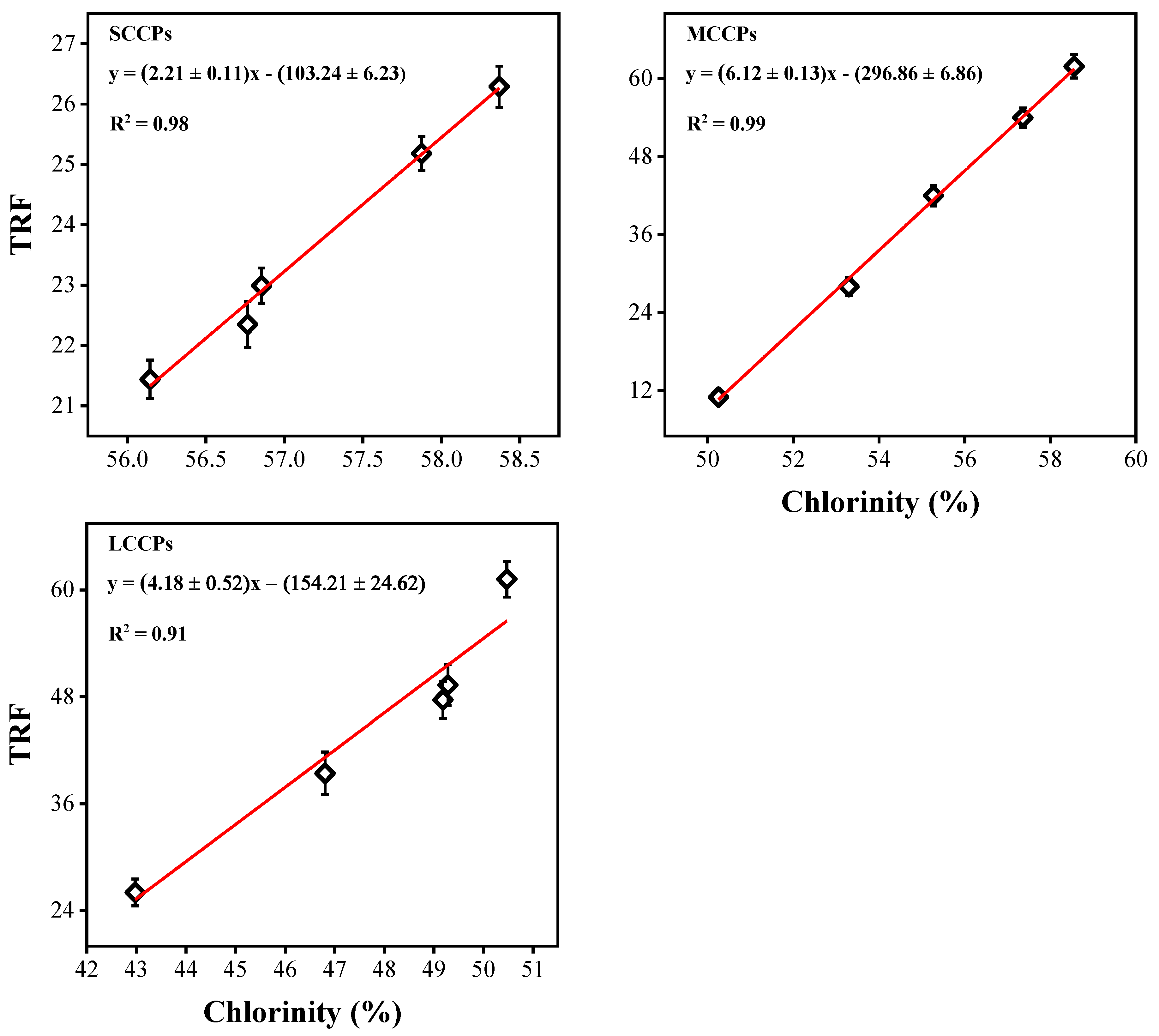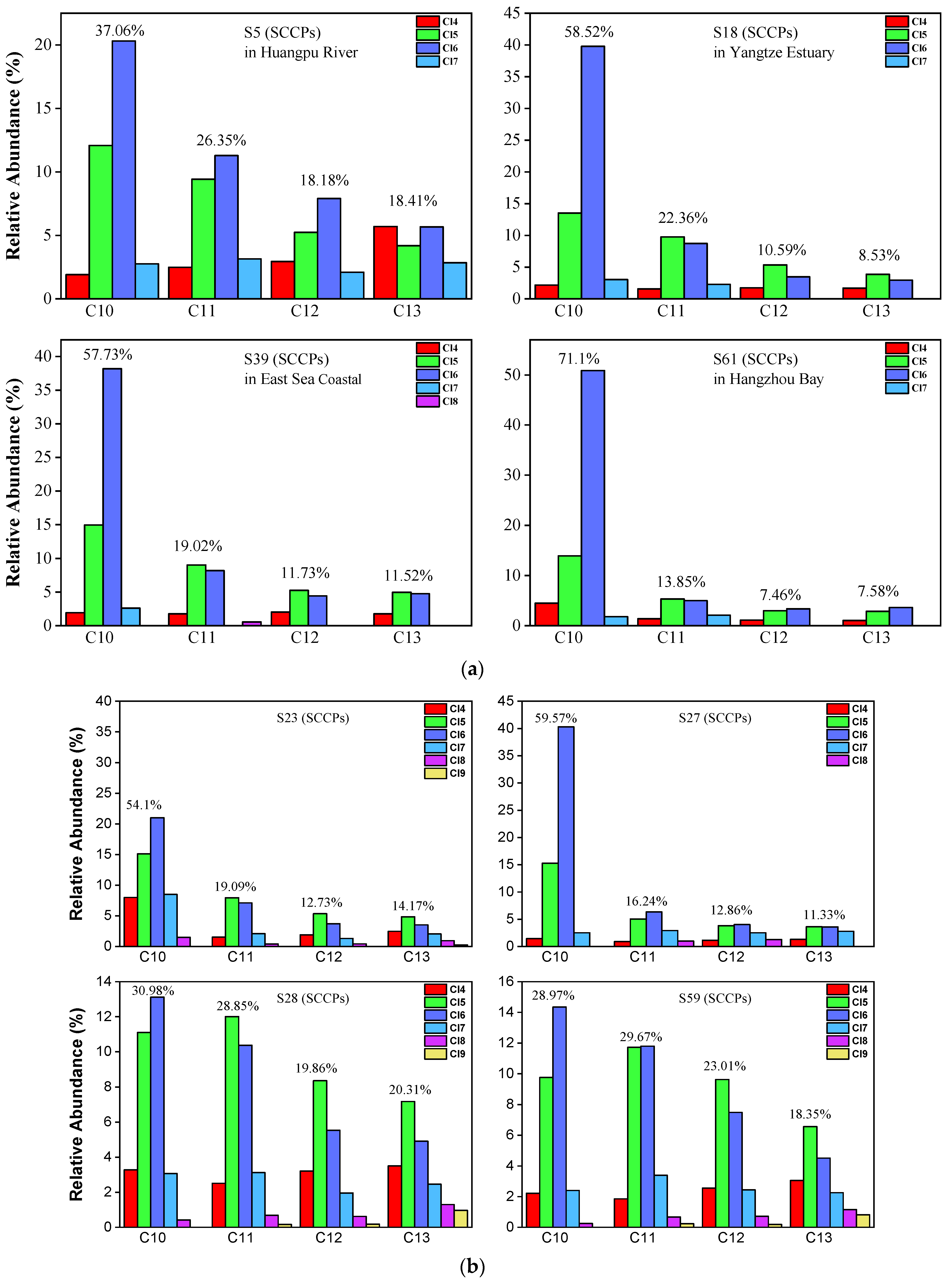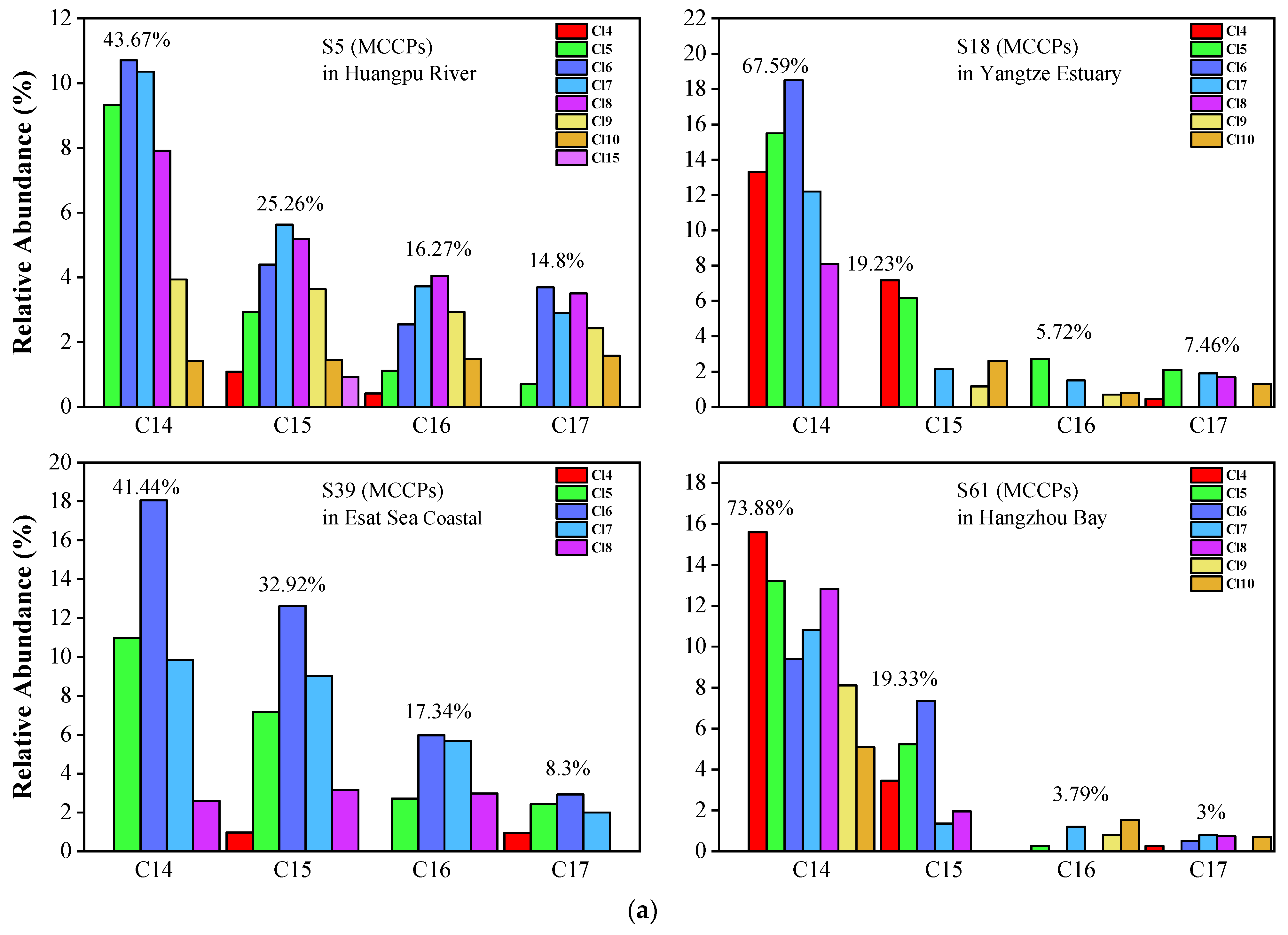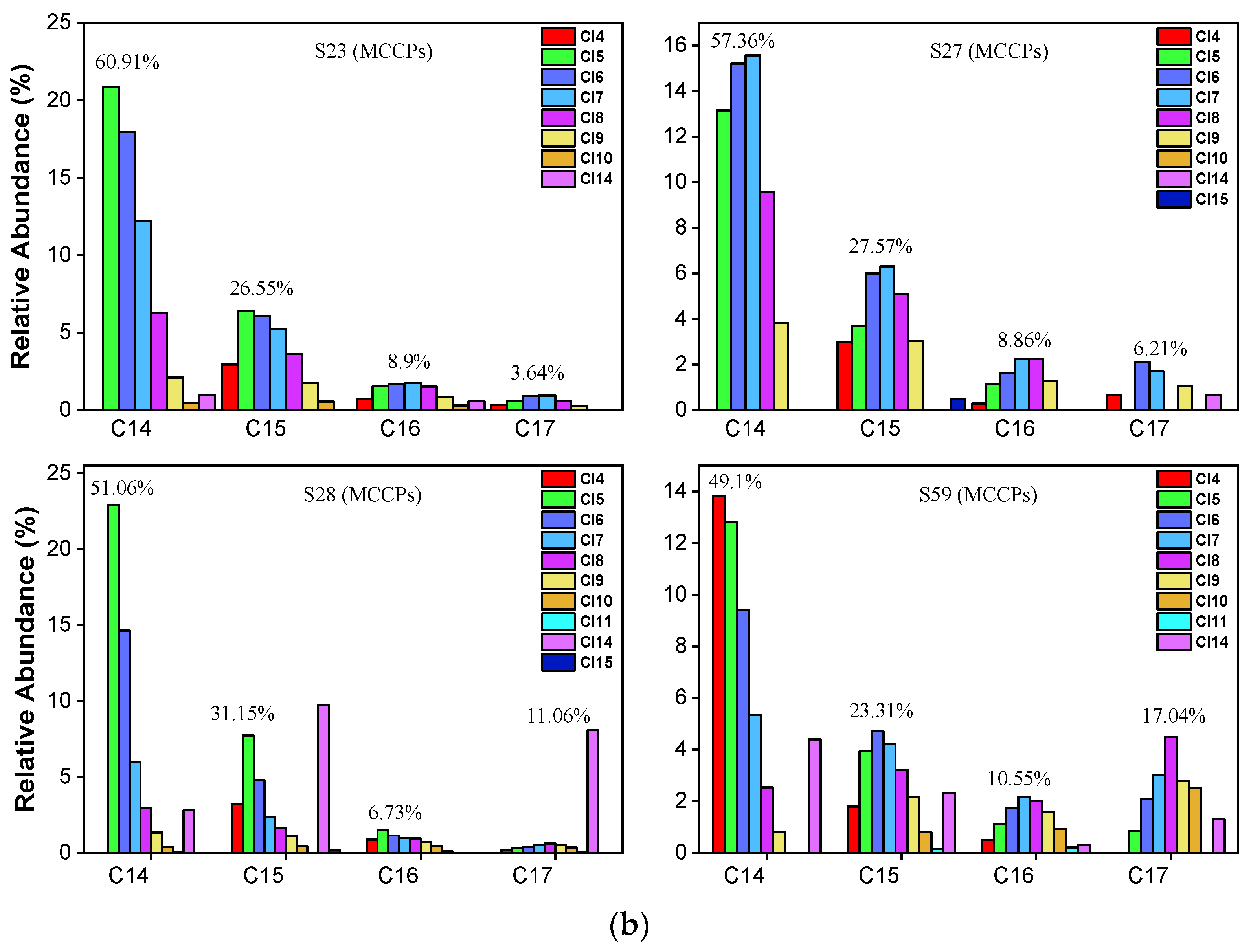Influence of Sediment Dredging on the Distribution of Chlorinated Paraffin
Abstract
:1. Introduction
2. Materials and Methods
3. Results and Discussion
3.1. Selecting the Determined Method
3.2. Concentrations of CPs in Sediments
3.3. Congener Group Profile of SCCPs in Sediments
3.4. Spatial Distribution of TOC and the Relationship with CPs
4. Conclusions
Supplementary Materials
Author Contributions
Funding
Informed Consent Statement
Acknowledgments
Conflicts of Interest
References
- Chen, M.; Luo, X.; Zhang, X.; He, M.; Chen, S.; Mi, B. Chlorinated paraffins in sediments from the Pearl River Delta, South China: Spatial and temporal distributions and implication for processes. Environ. Sci. Technol. 2011, 45, 9936–9943. [Google Scholar] [CrossRef]
- Bayen, S.; Obbard, J.P.; Thomas, G.O. Chlorinated paraffins: A review of analysis and environmental occurrence. Environ. Int. 2006, 32, 915–929. [Google Scholar] [CrossRef]
- Barber, J.L.; Sweetman, A.J.; Thomas, G.O.; Braekevelt, E.; Stern, G.A.; Jones, K.C. Spatial and temporal variability in air concentrations of short-chain (C10–C13) and medium-chain (C14–C17) chlorinated n-alkanes measured in the UK atmosphere. Environ. Sci. Technol. 2005, 39, 4407–4415. [Google Scholar] [CrossRef]
- Iozza, S.; Mueller, C.E.; Schmid, P.; Bogdal, C.; Oehme, M. Historical profiles of chlorinated paraffins and polychlorinated biphenyls in a dated sediment core from Lake Thun (Switzerland). Environ. Sci. Technol. 2008, 42, 1045–1050. [Google Scholar] [CrossRef]
- Iino, F.; Takasuga, T.; Senthilkumar, K.; Nakamura, N.; Nakanishi, J. Risk assessment of short-chain chlorinated paraffins in Japan based on the first market basket study and species sensitivity distributions. Environ. Sci. Technol. 2005, 39, 859–866. [Google Scholar] [CrossRef]
- Houde, M.; Muir, D.C.G.; Tomy, G.T.; Whittle, D.M.; Teixeira, C.; Moore, S. Bioaccumulation and trophic magnification of short- and medium-chain chlorinated paraffins in food webs from lake ontario and lake michigan. Environ. Sci. Technol. 2008, 42, 3893–3899. [Google Scholar] [CrossRef]
- Hussy, I.; Webster, L.; Russell, M.; Moffat, C. Determination of chlorinated paraffins in sediments from the firth of clyde by gas chromatography with electron capture negative ionisation mass spectrometry and carbon skeleton analysis by gas chromatography with flame ionisation detection. Chemosphere 2012, 88, 292–299. [Google Scholar] [CrossRef]
- van Mourik, L.M.; Gaus, C.; Leonards, P.E.G.; de Boer, J. Chlorinated paraffins in the environment: A review on their production, fate, levels and trends between 2010 and 2015. Chemosphere 2016, 155, 415–428. [Google Scholar] [CrossRef]
- Wang, Y.; Gao, W.; Jiang, G. Strengthening the study on the behavior and transformation of medium-chain chlorinated paraffins in the environment. Environ. Sci. Technol. 2017, 51, 10282–10283. [Google Scholar] [CrossRef]
- Feo, M.L.; Eljarrat, E.; Barcelo, D. Occurrence, fate and analysis of polychlorinated n-alkanes in the environment. Trac-Trends Anal. Chem. 2009, 28, 778–791. [Google Scholar] [CrossRef]
- Yuan, B.; McLachlan, M.S.; Roos, A.M.; Simon, M.; Strid, A.; de Wit, C.A. Long-chain chlorinated paraffins have reached the arctic. Environ. Sci. Technol. Lett. 2021, 8, 753–759. [Google Scholar] [CrossRef]
- Zhou, Y.; Yin, G.; Du, X.; Xu, M.; Qiu, Y.; Ahlqvist, P.; Chen, Q.; Zhao, J. Short-chain chlorinated paraffins (SCCPs) in a freshwater food web from Dianshan Lake: Occurrence level, congener pattern and trophic transfer. Sci. Total Environ. 2018, 615, 1010–1018. [Google Scholar] [CrossRef]
- Zhang, C.; Chang, H.; Wang, H.; Zhu, Y.; Zhao, X.; He, Y.; Sun, F.; Wu, F. Spatial and temporal distributions of short-, medium-, and long-chain chlorinated paraffins in sediment cores from nine lakes in China. Environ. Sci. Technol. 2019, 53, 9462–9471. [Google Scholar] [CrossRef]
- Gao, Y.; Zhang, H.; Su, F.; Tian, Y.; Chen, J. Environmental occurrence and distribution of short chain chlorinated paraffins in sediments and soils from the Liaohe River Basin, P.R. China. Environ. Sci. Technol. 2012, 46, 3771–3778. [Google Scholar] [CrossRef]
- Xu, J.; Gao, Y.; Zhang, H.; Zhan, F.; Chen, J. Dispersion of short- and medium-chain chlorinated paraffins (CPs) from a CP production plant to the surrounding surface soils and coniferous leaves. Environ. Sci. Technol. 2016, 50, 12759–12766. [Google Scholar] [CrossRef]
- Da, C.; Wang, R.; Xia, L.; Huang, Q.; Cai, J.; Cai, F.; Gao, C. Sediment records of polybrominated diphenyl ethers (PBDEs) in Yangtze River Delta of Yangtze River in China. Mar. Pollut. Bull. 2020, 160, 111714. [Google Scholar] [CrossRef]
- Li, T.; Wan, Y.; Gao, S.; Wang, B.; Hu, J. High-throughput determination and characterization of short-, medium-, and long-chain chlorinated paraffins in human blood. Environ. Sci. Technol. 2017, 51, 3346–3354. [Google Scholar] [CrossRef]
- Wu, C.; Wei, Y.D.; Huang, X.; Chen, B. Economic transition, spatial development and urban land use efficiency in the Yangtze River Delta, China. Habitat Int. 2017, 63, 67–78. [Google Scholar] [CrossRef]
- Zeng, L.; Zhao, Z.; Li, H.; Thanh, W.; Liu, Q.; Xiao, K.; Du, Y.; Wang, Y.; Jiang, G. Distribution of short chain chlorinated paraffins in marine sediments of the East China Sea: Influencing factors, transport and implications. Environ. Sci. Technol. 2012, 46, 9898–9906. [Google Scholar] [CrossRef]
- Zeng, L.; Chen, R.; Zhao, Z.; Wang, T.; Gao, Y.; Li, A.; Wang, Y.; Jiang, G.; Sun, L. Spatial distributions and deposition chronology of short chain chlorinated paraffins in marine sediments across the chinese bohai and Yellow Seas. Environ. Sci. Technol. 2013, 47, 11449–11456. [Google Scholar] [CrossRef]
- Zeng, L.; Lam, J.C.W.; Wang, Y.; Jiang, G.; Lam, P.K.S. Temporal trends and pattern changes of short- and medium-chain chlorinated paraffins in marine mammals from the South China Sea over the past decade. Environ. Sci. Technol. 2015, 49, 11348–11355. [Google Scholar] [CrossRef] [PubMed]
- Liu, Y.; Chen, L.; Huang, Q.; Li, W.; Tang, Y.; Zhao, J. Source apportionment of polycyclic aromatic hydrocarbons (PAHs) in surface sediments of the Huangpu River, Shanghai, China. Sci. Total Environ. 2009, 407, 2931–2938. [Google Scholar] [CrossRef] [PubMed]
- Chibwe, L.; Myers, A.L.; De Silva, A.O.; Reiner, E.J.; Jobst, K.; Muir, D.; Yuan, B. C12-30 alpha-bromo-chloro "Alkenes": Characterization of a poorly identified flame retardant and potential environmental implications. Environ. Sci. Technol. 2019, 53, 10835–10844. [Google Scholar] [CrossRef] [PubMed]
- Zhao, Z.; Li, H.; Wang, Y.; Li, G.; Cao, Y.; Zeng, L.; Lan, J.; Wang, T.; Jiang, G. Source and migration of short-chain chlorinated paraffins in the Coastal East China Sea using multiproxies of marine organic geochemistry. Environ. Sci. Technol. 2013, 47, 5013–5022. [Google Scholar] [CrossRef]
- Zeng, L.; Wang, T.; Han, W.; Yuan, B.; Liu, Q.; Wang, Y.; Jiang, G. Spatial and vertical distribution of short chain chlorinated paraffins in soils from wastewater irrigated farmlands. Environ. Sci. Technol. 2011, 45, 2100–2106. [Google Scholar]
- Reth, M.; Zencak, Z.; Oehme, M. New quantification procedure for the analysis of chlorinated paraffins using electron capture negative ionization mass spectrometry. J. Chromatogr. A 2005, 1081, 225–231. [Google Scholar]
- Hollies, J.I.; Pinnington, D.F.; Handley, A.J.; Baldwin, M.K.; Bennett, D. The determination of chlorinated long-chain paraffins in water, sediment and biological samples. Anal. Chim. Acta 1979, 111, 201–213. [Google Scholar] [CrossRef]
- Campbell, I.; Mcconnell, G. Chlorinated paraffins and the environment.1. environmental occurrence. Environ. Sci. Technol. 1980, 14, 1209–1214. [Google Scholar] [CrossRef]
- Randegger-Vollrath, A. Determination of chlorinated paraffins in cutting fluids and iubricants. Fresenius J. Anal. Chem. 1998, 360, 62–68. [Google Scholar] [CrossRef]
- Coelhan, M. Determination of short chain polychlorinated paraffins in fish samples by short column GC/ECNI-MS. Anal. Chem. 1999, 71, 4498–4505. [Google Scholar]
- Korytar, P.; Parera, J.; Leonards, P.E.G.; Santos, F.J.; de Boer, J.; Brinkman, U.A.T. Characterization of polychlorinated n-alkanes using comprehensive two-dimensional gas chromatography-electron-capture negative. Ionisation time-of-flight mass spectrometry. J. Chromatogr. A 2005, 1086, 71–82. [Google Scholar] [CrossRef] [PubMed]
- Zencak, Z.; Borgen, A.; Reth, M.; Oehme, M. Evaluation of four mass spectrometric methods for the gas chromatographic analysis of polychlorinated n-alkanes. J. Chromatogr. A 2005, 1067, 295–301. [Google Scholar] [CrossRef] [PubMed]
- Tomy, G.T.; Fisk, A.T.; Westmore, J.B.; Muir, D.C. Environmental chemistry and toxicology of polychlorinated n-alkanes. Rev. Environ. Contam. Toxicol. 1998, 158, 53–128. [Google Scholar] [PubMed]
- Moore, S.; Vromet, L.; Rondeau, B. Comparison of metastable atom bombardment and electron capture negative ionization for the analysis of polychloroalkanes. Chemosphere 2004, 54, 453–459. [Google Scholar] [CrossRef]
- Van Mourik, L.M.; Leonards, P.E.G.; Gaus, C.; de Boer, J. Recent developments in capabilities for analysing chlorinated paraffins in environmental matrices: A review. Chemosphere 2015, 136, 259–272. [Google Scholar] [CrossRef]
- Schinkel, L.; Lehner, S.; Heeb, N.V.; Lienemann, P.; McNeill, K.; Bogdal, C. Deconvolution of mass spectral interferences of chlorinated alkanes and their thermal degradation products: Chlorinated alkenes. Anal. Chem. 2017, 89, 5923–5931. [Google Scholar] [CrossRef]
- Zheng, L.; Lian, L.; Nie, J.; Song, Y.; Yan, S.; Yin, D.; Song, W. Development of an ammonium chloride-enhanced thermal-assisted-ESI LC-HRMS method for the characterization of chlorinated paraffins. Environ. Pollut. 2019, 255, 113303. [Google Scholar] [CrossRef]
- Wang, X.; Xu, S.; Wang, X.; Hu, B.; Jia, H. Occurrence, homologue patterns and source apportionment of short- and medium-chain chlorinated paraffins in suburban soils of Shanghai, China. Chemosphere 2017, 180, 302–311. [Google Scholar] [CrossRef]
- Wang, X.; Zhu, J.; Xue, Z.; Jin, X.; Jin, Y.; Fu, Z. The environmental distribution and toxicity of short-chain chlorinated paraffins and underlying mechanisms: Implications for further toxicological investigation. Sci. Total Environ. 2019, 695, 133834. [Google Scholar] [CrossRef]
- Zheng, X.; Sun, Q.; Wang, S.; Li, X.; Liu, P.; Yan, Z.; Kong, X.; Fan, J. Advances in studies on toxic effects of short-chain chlorinated paraffins (SCCPs) and characterization of environmental pollution in China. Arch. Environ. Contam. Toxicol. 2020, 78, 501–512. [Google Scholar] [CrossRef]
- Fisk, A.T.; Tomy, G.T.; Muir, D.C.G. Toxicity of C10-, C11-, C12-, and C14-polychlorinated alkanes to Japanese medaka (Oryzias latipes) embryos. Environ. Toxicol. Chem. 1999, 18, 2894–2902. [Google Scholar]
- Gluege, J.; Schinkel, L.; Hungerbuehler, K.; Cariou, R.; Bogdal, C. Environmental risks of medium-chain chlorinated paraffins (MCCPs): A review. Environ. Sci. Technol. 2018, 52, 6743–6760. [Google Scholar] [CrossRef] [PubMed]
- Li, C.; Chen, L.; He, Y.; Liang, Y.; Wang, Y.; Li, F.; Gao, W.; Wang, Y.; Jiang, G. Migration mechanism and risk assessment of chlorinated paraffins in highly polluted Ya’Er lake area, China. Environ. Pollut. 2021, 281, 117015. [Google Scholar] [CrossRef]
- Zhu, Z.Y.; Zhang, J.; Wu, Y.; Lin, J. Bulk particulate organic carbon in the East China Sea: Tidal influence and bottom transport. Prog. Oceanogr. 2006, 69, 37–60. [Google Scholar] [CrossRef]






| Number | Instrumental Technique | CPs | LOD (μg L−1) | Reference |
|---|---|---|---|---|
| 1 | TLC | SCCPs/MCCPs/LCCPs | * | [27,28] |
| 2 | GC/ECD | SCCPs/MCCPs | * | [29] |
| 3 | GC/ECNI-MS | SCCPs/MCCPs | 500 | [30,31,33] |
| 4 | GC/NICI-MS | SCCPs/MCCPs | * | [32] |
| 5 | GC/MAB | SCCPs | * | [34] |
| 6 | CH2Cl2-enhanced HPLC/EI-MS/MS, APCI-MS/MS, or ESI-MS-MS | SCCPs/MCCPs/LCCPs | 10 to 1200 | [17,35,36] |
| 7 | NH4Cl-enhanced HPLC/EI-MS/MS, APCI-MS/MS or ESI-MS-MS | SCCPs/MCCPs/LCCPs | 10 to 20 | [37] |
Publisher’s Note: MDPI stays neutral with regard to jurisdictional claims in published maps and institutional affiliations. |
© 2022 by the authors. Licensee MDPI, Basel, Switzerland. This article is an open access article distributed under the terms and conditions of the Creative Commons Attribution (CC BY) license (https://creativecommons.org/licenses/by/4.0/).
Share and Cite
Yang, T.; Deng, B.; Miao, C. Influence of Sediment Dredging on the Distribution of Chlorinated Paraffin. Water 2022, 14, 3461. https://doi.org/10.3390/w14213461
Yang T, Deng B, Miao C. Influence of Sediment Dredging on the Distribution of Chlorinated Paraffin. Water. 2022; 14(21):3461. https://doi.org/10.3390/w14213461
Chicago/Turabian StyleYang, Tao, Bangping Deng, and Chenyong Miao. 2022. "Influence of Sediment Dredging on the Distribution of Chlorinated Paraffin" Water 14, no. 21: 3461. https://doi.org/10.3390/w14213461
APA StyleYang, T., Deng, B., & Miao, C. (2022). Influence of Sediment Dredging on the Distribution of Chlorinated Paraffin. Water, 14(21), 3461. https://doi.org/10.3390/w14213461






